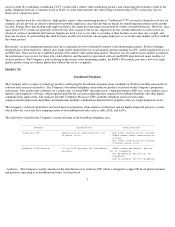8x8 1999 Annual Report Download - page 6
Download and view the complete annual report
Please find page 6 of the 1999 8x8 annual report below. You can navigate through the pages in the report by either clicking on the pages listed below, or by using the keyword search tool below to find specific information within the annual report.
product made it unlikely that the consumer videophone business would be profitable in the foreseeable future. Therefore, the Company
announced in April 1999 that it would cease production of the ViaTV product line and withdraw from its distribution channels over the
subsequent several quarters.
In June 1998, the Company entered the market for video monitoring products with its RSM-1500 Remote Surveillance Module. The RSM-
1500 module enables real-time remote video monitoring over POTS lines. Its target market is primarily owners of small businesses such as
convenience stores and restaurants who need the ability to view their premises from any remote location in the world at any time. The
Company currently sells its RSM-1500 module product to security distributors and dealers in North America, and is attempting to expand its
distribution channels into Europe and Asia. The Company intends to continue developing, manufacturing and marketing its Video Monitoring
products and to address new opportunities in the video monitoring market enabled by IP communications, such as broadband connections and
streaming video over the Internet.*
The Company entered the market for VoIP products in December 1998 with the announcement of its Audacity Internet Telephony Processor.
The Audacity processor combines IP telephony protocol support with audio compression/decompression capability and runs multiple
simultaneous IP phone calls on a single integrated circuit. In April 1999, the Company announced its Symphony VoIP module, an integrated
system product that is based on the Audacity semiconductor and that connects up to four analog telephone lines to an IP network. The
Company's VoIP products target OEM manufacturers of telephony equipment such as cable and DSL modems for residential applications and
PBX equipment for business applications.
The Company has recently organized into two business units. The first business unit, Broadband Telephony, markets the Company's
telecommunications products to OEMs. This business unit's product line includes the Audacity processor, the Symphony VoIP module, and the
Company's videoconferencing and videophone semiconductors. The second business unit, Video Monitoring, markets the Company's
monitoring products under the RSM brand name to end users. In addition, the Company will continue to sell its existing inventory of ViaTV
videophone products through select channels over the next several quarters.
In May 1999, the Company announced that it had entered into a definitive agreement to acquire Odisei S.A., a privately held, development
stage company based in Sophia Antipolis, France, that develops Internet protocol telephony software. Odisei is developing a scalable, Java-
based software solution for managing VoIP networks. The software will run on a carrier-grade server located at a telephony service provider's
site and will provide complete voice and data services over T1/E1, xDSL or cable communication links.
INDUSTRY BACKGROUND
Broadband Telephony
Traditional telecommunications networks such as the PSTN, ISDN, and corporate PBXs utilize a "circuit-switched" topology in which two
communicating terminals (e.g. telephones or videophones) are connected via a fixed electrical path that travels through a series of switches
across the network. In many cases, the connection between the terminals consists of both analog and digital components; for example a normal
residential phone call uses an analog connection from each caller's house to the closest telephone exchange, and a digital connection between
the exchanges. The circuit-switched topology allots a fixed bandwidth to the digital component of the connection; typically this is 64 kilobits
per second (Kbps) for a voice call.
Circuit-switched networks such as the PSTN have been built over decades for the single purpose of carrying real-time voice communications.
These networks feature very high reliability, a guaranteed quality of
* This statement is a forward looking statement reflecting current expectations. There can be no assurance that the Company's actual future
performance will meet the Company's current expectations. See "Manufacturing" commencing on page 15, "Competition" commencing on
page 13 and "Factors That May Affect Future Results" commencing on page 17 for a discussion of certain factors that could affect future
performance.
2



















